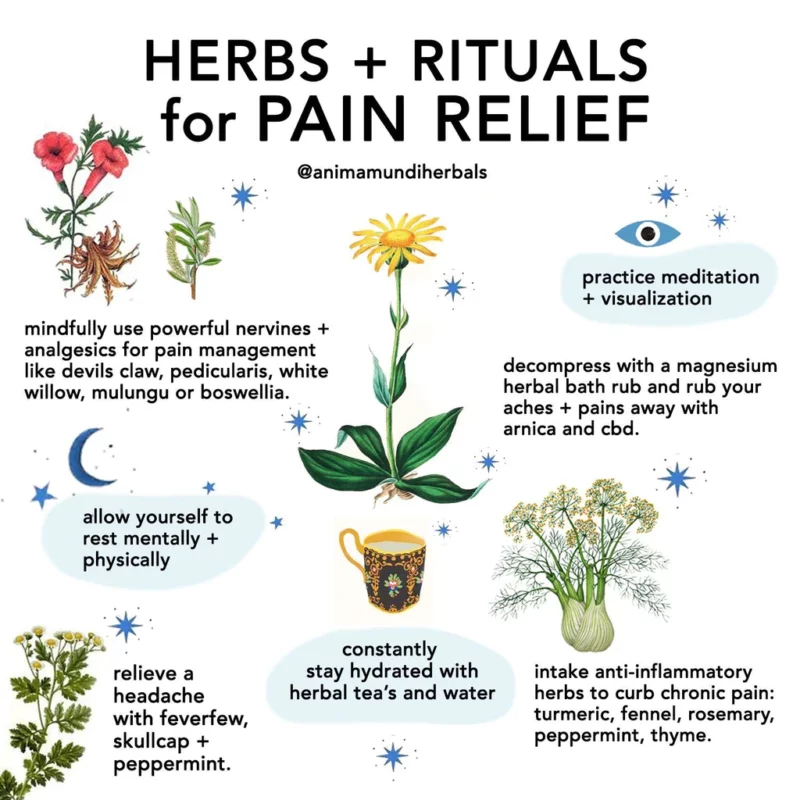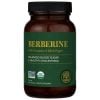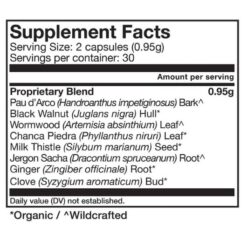Anima Mundi, Beauty News
The Comprehensive Guide to Natural Pain Relief: Herbs and the Science of Pain
In today’s fast-paced world, quick fixes like over-the-counter medications are often the go-to solutions for pain relief. However, it’s essential to remember that these are relatively recent remedies in the grand timeline of human history. For thousands of years, individuals have turned to various plants and mental strategies to manage both psychological and physical pain. This comprehensive guide will delve into some potent herbs for topical pain relief, as well as explore the fascinating science of pain itself.
Understanding the Nature of Pain
What exactly is pain? According to the International Association for the Study of Pain, pain is not just a physical sensation but an overall experience. It’s generally triggered when body tissues signal a potential threat. These signals are carried by neurons known as ‘nociceptors,’ which are essentially the body’s danger sensors. However, the existence of nociceptors isn’t a guarantee that pain will be experienced; they simply carry the potential for it.
Experts in the field often assert that pain is more a construct of the mind than of the body. When a ‘danger’ signal reaches the brain, the brain has to assess how perilous the situation actually is. It uses a broad range of information to make this judgment, including past experiences, cultural norms, additional sensory inputs, and much more.
The concept of “mind over matter” aptly describes scenarios where mental focus overrides bodily discomfort. Consider a gardener who only notices a cut on her hand after she’s finished her work, or a soldier who feels no pain from a bullet wound until he is in a safe environment. Researchers in pain science attribute this phenomenon to the complexity of the human brain, which allows for the modulation of pain intensity in specific circumstances.

Methods of Application
Pain relief through natural remedies can be achieved through various methods of application. You can use these herbs as oils, creams, poultices, or even in steamed form for medicinal baths and foot soaks. The best method will depend on the nature of your pain or injury, so consult a healthcare professional for personalized advice.

Let’s Get Deep With Plants.
There are more than 100 plants known to have pain-relieving properties, but some are really outstanding. Below are just some of our personal favorites for internal and external uses, but there is certainly a lot more within our pharmacopeia that aren’t listed, or need more researched.
1. Devil’s Claw: The Muscle Relaxer
Devil’s Claw is well-known for its muscle-relaxing benefits, particularly targeting pain in the back, shoulders, and neck. Not only does it relieve tension in the muscles, but it’s also a popular remedy for pain related to osteoarthritis and potentially rheumatoid arthritis. The key components behind its effectiveness are harpagide and harpagoside—natural substances known for their pain-relieving and anti-inflammatory properties. Research indicates that Devil’s Claw can reduce osteoarthritic pain in the hip or knee by a quarter and significantly enhance mobility within a matter of weeks. In the case of rheumatoid arthritis, both pain and mobility can improve in about two months.
Note of Caution: Avoid Devil’s Claw if you’re taking blood thinners or if you are pregnant, nursing, or have liver, kidney, or digestive issues.
2. Capsaicin: Your Spicy Companion for Pain Relief
Capsaicin, the compound that gives hot peppers their fiery kick, plays a role in pain management. It’s proven to interrupt the body’s perception of pain, stimulate the release of endorphins, and act as a natural analgesic. You can find capsaicin in commercial creams like Zostrix, Heet, and Capzasin-P, which are commonly used for arthritis and nerve-related pain. Specifically, creams with a .025% capsaicin concentration can drastically alleviate osteoarthritic pain when applied to joints four times a day. For peripheral nerve pain, such as diabetic nerve damage or pain post-cancer surgery, a .075% concentration is more effective.
Note of Caution: Avoid touching your eyes or other sensitive areas after applying capsaicin creams.
3. Mulungu: The Amazonian Calm-Inducer
Mulungu, an indigenous tree from Central and South America, is celebrated for its anti-anxiety, sedative, and muscle-relaxing properties. Traditional medicine in these regions has long used Mulungu for pain management, mental well-being, liver health, and cardiovascular issues. Modern research backs its use as an anti-nociceptive, reducing the body’s sensitivity to painful stimuli, and as a substance with anti-convulsive, neuroprotective, and anti-inflammatory properties.
Note of Caution: High doses could lead to drowsiness and may not be suitable for those with low blood pressure.
4. Pedicularis: America’s Native Nerve-Calmer
Native to North America, Pedicularis has a long-standing reputation as a muscle and skeletal relaxant. It’s commonly employed for general aches, sore muscles, and particularly back, shoulder, and neck pain. Though it’s not a complete painkiller, it can minimize the necessity for stronger medications. Its general safety record is commendable, with the most common side effect being mild disorientation, which could benefit those with anxiety.
5. Willow Bark: The Natural Aspirin
Willow bark has been dubbed “nature’s aspirin” due to its pain-relieving and anti-inflammatory qualities. Its active ingredient, salicin, combined with flavonoids and other plant elements, makes it an effective natural remedy. It’s particularly useful for those suffering from chronic headaches or back pain.
Note of Caution: Overuse for an extended period may result in stomach cramps.
6. Kratom: The Herbal Opioid
Kratom engages with the brain’s mu-opioid receptors, much like traditional opioids. Active compounds like mitragynine and 7-hydroxymitragynine latch onto these receptors, reducing pain perception. In recent years, it has gained traction as a herbal alternative to opioid medications, often used for chronic pain management and symptoms of opioid withdrawal.
Note of Caution: Use cautiously as it could lead to dependence, and it should not be mixed with other painkillers. The side effect profile is broad and varies depending on usage and individual health conditions.
Topical Herbal Remedies for Pain Relief
Arnica
Arnica is often used in creams and homeopathic tablets to relieve osteoarthritic knee pain and post-surgery pain in the carpal tunnel. It contains helenin, an analgesic, and anti-inflammatory compounds. Note: Internal consumption is not advised without professional guidance.
Boswellia
This herb contains anti-inflammatory and analgesic boswellic acids. It is effective for sports injuries and osteoarthritic knee pain. Dosage usually ranges from 150 to 400 mg capsules or tablets, three times daily.
CBD
CBD is a type of cannabinoid that does not cause a “high” like THC. It can be applied topically and taken internally to manage chronic pain.
Blue Lotus
Since ancient Egypt, Blue Lotus has been used to relieve pain and anxiety. It contains nuciferine and apomorphine and has sedative-hypnotic properties.
Clove Oil
Excellent for toothaches, this oil has strong anti-inflammatory properties. Apply a drop directly to the affected tooth or cavity.
Feverfew
Famous for treating headaches and migraines, Feverfew can reduce both the frequency and severity of headaches when taken regularly.
Ginger
Known for its analgesic and anti-inflammatory properties, ginger can alleviate digestive cramps and mild fibromyalgia pain.
Lavender Essential Oil
Lavender oil may offer natural relief from pain and help with sleep and anxiety. However, avoid ingesting it and always dilute it in a carrier oil before topical application.
Oregano, Rosemary, and Thyme
Sprinkle these herbs generously onto your meals or infuse them in teas and broths. They contain a variety of anti-inflammatory and analgesic compounds.
Wild Dagga
This herb has a multitude of uses, including its strong anti-inflammatory, analgesic, antioxidant, anticonvulsant, and anthelmintic activities. It’s not hallucinogenic but has calming and euphoric effects.
Conclusion
While over-the-counter and prescription medications certainly have their place, these natural alternatives offer an array of options to consider. However, always consult a healthcare provider for proper diagnosis and treatment options suitable for you. Whether it’s a strained muscle or a more serious health condition, pain is a signal from your body that should not be ignored.
DOLORES Tonic: Your Natural Path to Pain Relief
Tired of the side effects from over-the-counter pain meds? Want a more natural option? Look no further than DOLORES Tonic, your natural choice for botanical relief.
Why Choose DOLORES Tonic?
Our meticulously crafted tonic blends the best of nature’s nervines—herbs specifically aimed at calming your nerves and managing pain. Unlike conventional pills that can take a toll on your liver, this plant-based tonic offers a gentler yet effective alternative.
How To Use
For optimum results, adhere to the recommended dose on the packaging. For personalized advice, consult a healthcare professional.
Key Perks
- Provides potential relief from inflammatory pain
- Rich in antioxidants
- May enhance mood and energy levels
What’s Inside?
- Mulungu Bark
- Blue Lotus Flower
- Indian Warrior Flower
- Elephantella Flower
- Wild Dagga Flower
- St. John’s Wort Leaf
Note: All our botanical ingredients are either wildcrafted or available in liquid extract form.
Other Ingredients
- Cane Spirits
- Vegetable Glycerin
- Filtered Water









































 Beauty Products
Beauty Products By Skintype
By Skintype Brands A-Z
Brands A-Z Wellness
Wellness Health / Nutrition
Health / Nutrition